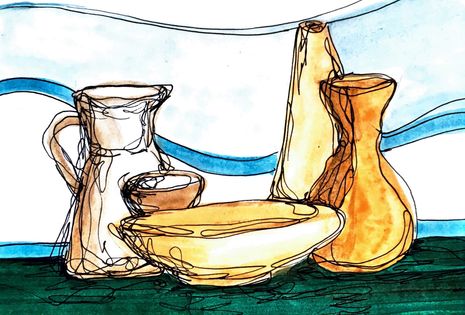Beating Perfectionism with Pottery
Amid the public’s current infatuation with the Great Pottery Throw Down and her family’s own connection to ceramics, Florence Brockman details her resistance to and reservations about the art form

Pottery is unnecessarily messy. Clay is unwieldy and the chance of disaster striking is just too high for my liking. Carved something to perfection? It will crack in the kiln. Spent hours painting your design? The oxidisation in the firing process will make it look a million miles away from what you envisioned. Pottery may appear fun in principle (no doubt due to a certain scene in Ghost) but for me, it was always a waste of time, leaving me with something uneven, ugly, and certainly unprofessional.
Considering my family's love affair with ceramics, casting, and all things clay, surely I too should have caught the bug by now? Having a granddad that designed Wedgwood ceramics means our house groans under the weight of crockery. But after all, a vase is just a vase; why spend so long, and risk so much, for something plain? A painting can tell a thousand words, but a vase is just liable to smash.
“As well as my cynicism, I was now a liability around clay too”
As I got older, this view developed into a hardened dislike for pottery. Thinking about ceramics now brings back a flood of memories from my job at a pottery painting studio during Sixth Form. The endless cycle of children’s birthday parties, frantic washing up, and attempting to get a handprint of a toddler’s palm while they screamed their head off is imprinted in my mind forevermore. Even on my last day, I smashed – accidentally I might add – a customer’s item, though thankfully not in front of them. As well as my cynicism, I was now a liability around clay too. I stayed firmly in the safe realms of acrylic, oil, and biro, where I was master of the materials and not the other way around.
So, when I sat down to watch The Great Pottery Throw Down, I was sceptical. Molding clay seemed even messier than painting it. Yet, I’ll admit I was captured. The command the potters had over the clay, making it dance upwards, shaping it into whatever they desired, was mesmerising. Of course, the element of jeopardy was still there: cracking in firing, deceiving glazes, uneven rims. But somehow, all the potters made it look so effortless.
After a surprisingly heady moment of inspiration mixed with desperate procrastination, I managed to unearth an unopened packet of clay, ordered a bunch of tools, and began. While there is undeniably something cathartic in rolling, pushing, and pulling clay, to form something is a different matter entirely. After an hour, the clay remained a stubborn lump, unwilling to give into my demands. While on television, head judge Keith Brymer Jones was tearing up over the beauty of clay, I was tearing up in frustration.
Settling eventually on making a phone holder for my desk didn’t make the task any easier. When I thought I had made a join successfully, another broke off, resulting in a frantic patch up with too much slip and a very heavy hand. Finally, once everything was seemingly stable, my creations were covered in fingerprints and scratches. Exhausted after hours of painstaking work, I surrendered; the clay had beaten me. I accepted defeat, only to come back the next day and make another dish, which was arguably worse than the first.
“it was liberating to explore something which fought back against my artistic superiority complex”
I still stand by my opinion that clay’s flaws lie in its messiness and chance. But I’ve also realised that clay’s beauty lies in its messiness and chance too. Thankfully, I managed to avoid any disastrous cracking in the drying process, but the ugly grooves from my fingernail still remained, a reminder of my painfully inexperienced career as a potter. Having realised too late that clay shrinks, my phone holder doesn’t even fit my phone. My creations are wobbly, and wonky, which no amount of sanding and paint can hide. Yet, since I didn’t have the skill to give my work the surgery it desperately needed, I was forced to embrace the beauty in the imperfection.
My experience, as I thought it would be, was disastrous. But instead of berating the clay and vowing never to return, it taught me to embrace patience and reject perfectionism in a world of demand. It was stupid of me to assume that my clay creations could ever be professional. Potters on The Great Pottery Throw Down ran into the same problems I experienced; the only difference is they knew how to fix them. I can fix them too – but only with practice. I’m not a full convert to ceramics yet and will certainly not be surrendering my biro or oils any time soon, but it was liberating to explore something which fought back against my artistic superiority complex. As I research what type of clay to buy next, I have a feeling it may become a new lockdown obsession.
 News / SU reluctantly registers controversial women’s soc18 December 2025
News / SU reluctantly registers controversial women’s soc18 December 2025 News / CUP announces funding scheme for under-represented academics19 December 2025
News / CUP announces funding scheme for under-represented academics19 December 2025 Features / Should I stay or should I go? Cambridge students and alumni reflect on how their memories stay with them15 December 2025
Features / Should I stay or should I go? Cambridge students and alumni reflect on how their memories stay with them15 December 2025 Fashion / The art of the formal outfit 18 December 2025
Fashion / The art of the formal outfit 18 December 2025 News / Dons warn PM about Vet School closure16 December 2025
News / Dons warn PM about Vet School closure16 December 2025










